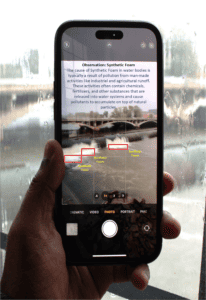 A Multimodal Vision-Based LLM
A Multimodal Vision-Based LLM
Dinesh Jackson Samuel
College of Engineering
IIHR Hydroscience and Engineering – Hydroinformatics Lab
Category: Faculty/Staff/Researchers
Water pollution has become a major concern in recent years, affecting over 2 billion people worldwide, according to UNESCO. This pollution can occur naturally, such as through algal blooms, or it can be man-made when toxic substances are released into water bodies like lakes, rivers, springs, and oceans. To address this issue and monitor surface-level water pollution in local water bodies, an informative real-time vision-based surveillance system has been developed in conjunction with Large Language Models (LLMs). This system utilizes the mobile camera to capture the field of view, which is then processed using vision algorithms. Subsequently, it is integrated with Large Language Models (LLMs) to generate contextual information regarding the type, causes, and impact of pollutants on both human health and the environment. This multi-model setup enables local authorities to monitor water pollution and take necessary steps to mitigate it. To train the vision model, seven major types of pollutants found in water bodies like algal bloom, synthetic foams, dead fishes, oil spills, wooden logs, industrial waste run-offs and trashes were used for achieving accurate detection. ChatGPT API has been integrated with the model to generate contextual information about pollution detected. Thus, the multi-model system can conduct surveillance over water bodies and autonomously alert local authorities to take immediate action, eliminating the need for human intervention.
Acknowledgements: Ibrahim Demir & Muhammed Yusuf Sermet
 A Reflection of Motherhood
A Reflection of Motherhood
Celine Fender
College of Education
EPLS: Higher Education and Student Affairs
Category: Graduate Student
This is a photo of me and my aunt Lisa when she was pregnant with her second child, my cousin Keenai. I wanted to be just like her so I stuffed a soccer ball up my tummy and laid with her. My family and I had just come to America and we had lived with my aunt and uncle before we found our own home. This photo is important to me because I study motherhood and gender equity now in my graduate program. I love this photo because even though I have never had my own child, I love how it shows how I have always been curious about mothering/motherhood – just as I am now. Though my aunt has never been a student-mother specifically, her work ethic and passion for achieving her goals have always inspired me. I study student-mothers because they are motivated, resourceful, and hardworking. I chose to study student-mothers from the perspective of success because women and mothers are very capable of hard and challenging ventures. Claiming student-mothers as victims and underachievers is an old narrative that perpetuates the gender inequalities within higher education systems. Scholars and practitioners need to be brought to light the accomplishments and high achievements of these student-mothers to break the cycle of student-mothers being ripped of their agency.
Acknowledgements: Lisa Fender, My Aunt
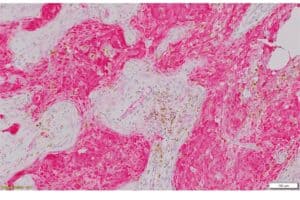 Baby Duck Wears Pink for Her Mom
Baby Duck Wears Pink for Her Mom
Xingshan Jiang
Carver College of Medicine
Pathology – Bing Li Research Lab
Category: Faculty/Staff/Researchers
This is an image of Immunohistochemistry staining on breast cancer tissue. The pink staining cancer cells look like a baby duck kissing her mom.
October is Breast Cancer Awareness Month, a time to increase awareness of the disease and raise funds for research into its cause, prevention, diagnosis, treatment, and cure. 1 in 8 women will be diagnosed with breast cancer in her lifetime in the United States every year. Known best for its pink theme color, the month features a number of campaigns and programs — conducted by groups ranging from breast cancer advocacy organizations to local community organizations to major retailers — aimed at:
- Supporting people diagnosed with breast cancer, including metastatic breast cancer
- Educating people about breast cancer risk factors
- Stressing the importance of regular screening, starting at age 40 or an age that’s appropriate for your personal breast cancer risk
- Fundraising for breast cancer research
I hope this image helps.
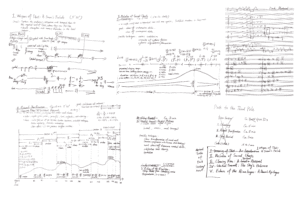 Behind the Notes: Sketch for “Path To The Third Pole”
Behind the Notes: Sketch for “Path To The Third Pole”
Vincent Cai
School of Music
Music Theory and Composition – Center for New Music
Category: Graduate Student
The photograph illustrates the preliminary sketch of my dissertation project titled “Path to the Third Pole”, a twenty-minute musical composition crafted for the University of Iowa Center for the New Music Ensemble. This project reflects my research in both acoustical and spiritual realms. Through this composition, I aim to portray various emblematic scenes from Tibet. The work is structured into five movements, designed to flow seamlessly into one another:
- Whispers of Tibet: A Dream’s Prelude
- Melodies of Sacred Chants
- Cleansing Rites: A Spiritual Renewal
- Celestial Farewell: The Sky’s Embrace
- Echoes of the Himalayas: A Dream’s Epilogue.
The raw sketch reveals the development of a large-scale musical piece, tracing its journey from primitive ideas to their eventual transformation over time. The section in the top right corner highlights the pitch materials, specifically two 9-tone pitch collections derived from the natural harmonic series, along with their shared chord properties. Structurally, the first movement offers performers the liberty to play at an undefined tempo (Senza Misura, Adagio e Largo con Rubato). While the fourth and fifth movements possess a more fluid structure, the second and third are more rigidly defined. The image at the top center demonstrates the concept of organically transitioning the tempo from a quarter note equaling 48 to 120, and then reverting to 60 using metric modulation techniques. The third movement showcases the juxtaposition of musical materials, aligned with the golden ratio principle.
Overall, the photograph elucidates the intricate process of managing various complexities in composing contemporary music, spanning pitch material, structural design, and musical development.
Acknowledgements: David Gompper
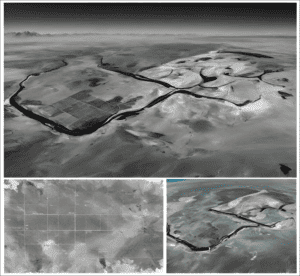 Bridging Past and Future with Remote Sensing and AI
Bridging Past and Future with Remote Sensing and AI
Zhouyayan (Iris) Li
College of Engineering
Civil and Environmental Engineering – IIHR Hydroscience and Engineering
Category: Graduate Student
Bridging Past and Future with Remote Sensing and AI is an image that encapsulates the essence of our groundbreaking research. In this study, we explored the feasibility of predicting ESA Sentinel-1 Synthetic-Aperture Radar (SAR) images by seamlessly combining historical data with an array of meteorological, surface condition, and geospatial input layers, all powered by state-of-the-art deep learning techniques. This marks a transformative shift from the retrospective application of Earth’s surface observation data to a proactive, forward-looking approach, where we prepare for incoming situations based on Earth’s surface predictions.
The image on top and the image down at the bottom-right are meant to represent the past and future Earth surface conditions viewed from a larger distance to give an overall impression. As we can see, they are similar but not exactly the same. The one at the bottom left shows an ortho image that gives more details about what the Earth image will look like.
Our research carries immense promise, particularly in fields like agriculture and natural hazard monitoring and mapping. It opens new doors, enhancing our capacity to anticipate and respond to real-time changes in critical areas. As we bridge the past and future with remote sensing, our work will contribute significantly to the realization of more sustainable and resilient practices, ensuring a better tomorrow for our planet.
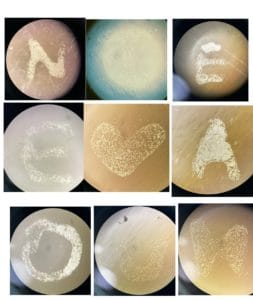 Cell Culture Art
Cell Culture Art
Heena Panchal
Carver College of Medicine
Microbiology and Immunology
Category: Faculty/Staff/Researchers
This artwork was created by culturing Human carcinoma cells (Adherent cells) in certain pattern. In this ground-breaking discipline, cells (which serve as the paint) are planted on tissue culture treated plate (which serves as a canvas) in desired shape , cell culture media serving as food, which then allow cells to grow in that particular shape. The cells I have used was A549 -Epithelial morphology, Microscopic size range from 10 -15μm, 2μL cell culture used for drawing.
Here I choose my favorite heart shape and some letters. Allowing cells to grow for 24-48hr in incubator and observe under microscope. Here I captured each microscopic field using iPhone (4x Magnification lens). Being a microbiologist, I have created art using bacterial cultures on agar plate but this time I want to try using Human cells.
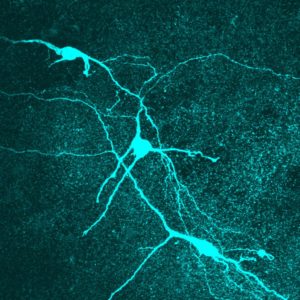 Dopamine Neurons of the Substantia Nigra
Dopamine Neurons of the Substantia Nigra
Erik Ingebretsen
Carver College of Medicine
Molecular Physiology and Biophysics
Category: Faculty/Staff/Researchers
Three cells in the rostral Substantia Nigra imaged on a confocal microscope using neurobiotin cell filling and tyrosine hydroxylase staining.
Acknowledgements: I would like to thank Dr. Stephanie Gantz for her help and expert mentorship
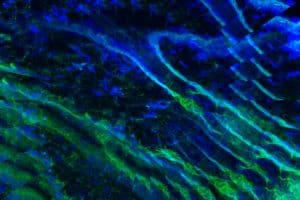 Geometric Follicle
Geometric Follicle
Cristina Dix
Carver College of Medicine
Dermatology – Jabbari Research Lab
Category: Faculty/Staff/Researchers
A cross-section of mouse skin with hair follicles was stained for MHC I in green and nuclei in blue. The mouse skin was treated with interferon-gamma which caused an immune response in the hair follicle and an upregulation in MHC I. The section of mouse skin was then imaged using a confocal microscope. A Python script was written to rotate and overlay the segments onto the image itself to add geometric effect and increase the depth of the imagery. The hair follicle meeting the epidermis of the skin can be seen towards the center with different sections of the hair follicle spiraled around the center.
Acknowledgements: Kristin Degraeve & Samuel Connell
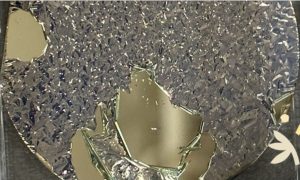 Golden Fall
Golden Fall
Fatima Toor
College of Engineering
Electrical and Computer Engineering – Iowa Technology Institute
Category: Faculty/Staff/Researchers
I am always fascinated by the fall colors. This image of a silicon wafer coated with aluminum, silicon nitride, silver, and titanium, reminded me of the fall leaves, in this case being golden than the red, orange, & yellow that I await around this time of every year.
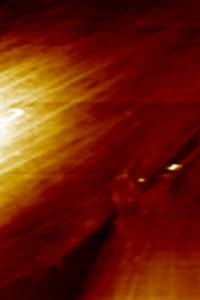 Human Cells and Their Cytoskeletons
Human Cells and Their Cytoskeletons
Kristan Worthington
College of Engineering
Biomedical Engineering – Worthington Lab
Category: Faculty/Staff/Researchers
The properties of a biomaterial, including its composition, stiffness, or architecture, can impact the behavior and identity of human cells. One focus of my lab is understanding the signaling pathways that underly these interactions and developing approaches to predict and control biomaterial-induced changes to human cells for the purpose of studying disease or advancing regenerative engineering technologies. Atomic force microscopy (AFM) is one tool that we use for small-scale characterization of the topography and stiffness of biomaterial surfaces, as well as the size, shape, and stiffness of attached cells. This AFM image is a color-coded height profile of two human fibroblasts interacting on a standard tissue culture plastic surface. The scan (33 microns x 50 microns) shows that the cells are elongated and spread thin on the surface, with a maximum height overlying one cell’s nucleus (white, 1.2 microns). The general structure of the cells’ underlying cytoskeletons is also revealed by the bright parallel lines seen in each cell. Cytoskeletal reorganization is one way that cells respond to mechanical cues, so mapping their structure gives us valuable insights about how cells are interacting with a biomaterial surface.
Acknowledgements: Qi Wang, Ed Sander, Matt Conway, & The Roy J. Carver Charitable Trust
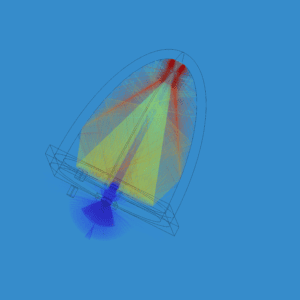 Laser Navigation Inside a 3D Printed Cavity
Laser Navigation Inside a 3D Printed Cavity
Rezwan Mohammad Sayeed
College of Engineering
Electrical and Computer Engineering – Toor Lab
Category: Graduate Student
Simulation of laser ray propagation inside a 3D printed cavity is showing how light rays are reflected from the Cr coated inner surfaces. Total path travelled by each light ray represents the optical path length (OPL) which can be correlated with Nitrous Oxide (N2O) gas molecules present in air inside the cavity. Using Beer-Lambert’s Law, the concentration of N2O can be detected from the OPL. Higher the OPL lower the limit of detection. Hence, the simulation is performed to design the optimum cavity to maximize the OPL inside.
Acknowledgements: Dr. Fatima Toor
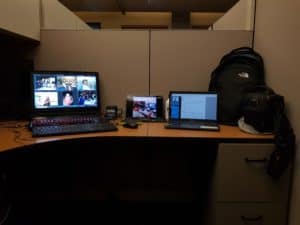 Long Journeys Through The Time
Long Journeys Through The Time
Ali Rahmani Qeranqayeh
College of Engineering
Informatics – IIHR Hydroscience and Engineering
Category: Graduate Student
Many people focus on the significant cultural differences between Iran and America during long journeys, but few understand the unique journey through time I’ve undertaken. Instead of traversing physical distances for the sake of skill and knowledge, researchers become time travelers, navigating the solitude of cities and keeping night vigils to enhance the human experience. This image showcases a progression from childhood to adulthood on the laptop, while the tablet displays a virtual reality project aimed at helping patients with mild cognitive impairment. The camera and backpack serve as companions on my temporal voyage.
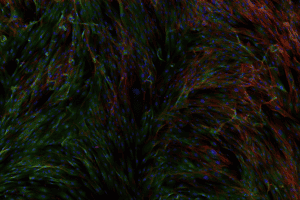 Myofibroblasts
Myofibroblasts
Austin Scholp
College of Engineering
Biomedical Engineering – Sander 3MT Lab
Category: Graduate Student
Myofibroblasts are a contractile phenotype of fibroblast that are activated in response to tissue injury. Their primary responsibility is to repair or replace damaged extracellular matrix via collagen production. They can be distinguished from other fibroblasts by their expression of alpha smooth muscle actin (αSMA). Expression of αSMA can be visualized via confocal microscopy. In this image, we see a colony of fibroblasts that have been treated to induce myofibroblast differentiation. Cell nuclei are stained blue using Hoechst stain while f-actin, an actin variant found in several cell types, is stained in red using phalloidin. The αSMA is stained green using an antibody stain combined with a fluorophore.
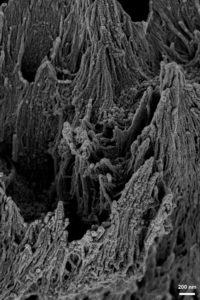 Nanofibrillar Structures Pulled Out From The Cross-Section Surface Of A 3D-Printed Silk Fibroin
Nanofibrillar Structures Pulled Out From The Cross-Section Surface Of A 3D-Printed Silk Fibroin
Reza Amouzandeh
College of Engineering
Biomedical Engineering – Mu Lab
Category: Graduate Student
The image exhibits the nanofibrillar structures pulled out from the cross-section surface of a 3D-printed silk fibroin film using a scanning electron microscope at the Central Microscopy Research Facility at the University of Iowa. Silk fibroin is a protein and a structural basis of domestic B. Mori silkworm cocoons, which have been used as luxury commodities and medical materials for thousands of years. Silk proteins are an engineering marvel because the fabrication process is under ambient and aqueous conditions and relies on minimal energy input but gives rise to mechanical superiority comparable to high-tensile steels. The silk nanofibrils are an intermediate structure playing a central role in the hierarchical assembly of silk proteins from single water-soluble molecules to macroscopic solid materials. The nanofibrils shown in the image are around 100 nanometers in diameter and exhibit the aggregation of micelle-like structures, resembling the native ones, but are constructed in an artificial and engineering approach, i.e., a salt bath-assisted 3D printing, and underly the desired mechanical performance to the 3D proteinaceous prints. Most likely governed by the Hoffmeister series, the composition and concentration of salt ions determine the assembling pathways of silk proteins, which is related to the mechanics and morphology of the nanofibrils. The molecular manipulation at the nanometer scale, e.g., the formation of nanofibrils, is important in developing advanced fabrication techniques that will enhance the efficacy of biomedical devices and scaffolds and promote environmental sustainability.
Acknowledgements: Prof. Xuan Mu
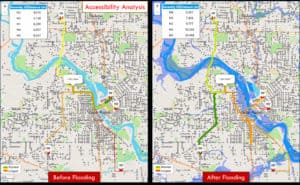 Navigating Flood Impacts: Enhancing Accessibility and Preparedness
Navigating Flood Impacts: Enhancing Accessibility and Preparedness
Yazeed Alabbad
College of Engineering
Civil and Environmental Engineering – IIHR Hydroscience and Engineering
Category: Graduate Student
Flooding significantly impacts transportation systems, causing physical damage and adverse consequences, such as cutting off access or increasing travel distances to essential services. Despite frequent flood occurrences affecting thousands, accessible online tools for flood risk analysis, routing, emergency planning, and response, particularly for the public, are limited. Existing tools are complex and not user-friendly. This research introduces a web application that uses graph network methods and modern web technologies to describe flood events in terms of operational constraints. It provides analytical methods to support mobility and mitigation decisions during such events. The accompanying image illustrates accessibility analysis applied to Cedar Rapids, focusing on the nearest hospitals. It reveals how the shortest paths change during flooding, with darker green paths indicating the shortest distances. Notably, the fourth-closest hospital in the baseline scenario becomes the nearest reachable hospital during flooding, emphasizing the significant impact on accessibility to critical facilities like hospitals, with implications for emergency response and recovery. My developed system also includes useful functions like location-allocation and service coverage during flooding, with the goal of expanding its reach to all U.S. communities in the future. This tool empowers individuals and communities to make informed decisions for effective flood preparedness, including site selection for essential buildings, route avoidance during flooding, identification of evacuation routes, and swift recovery from flood-related disruptions.
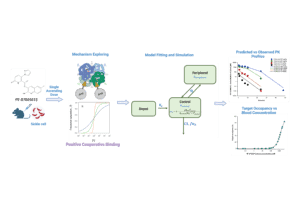 New Type of Target‑Mediated Drug Disposition By Its High‑Capacity Pharmacological Target Hemoglobin With Positive Cooperative Binding
New Type of Target‑Mediated Drug Disposition By Its High‑Capacity Pharmacological Target Hemoglobin With Positive Cooperative Binding
Min Xu
College of Pharmacy
Pharmaceutical Sciences and Experimental Therapeutics
Category: Graduate Student
PF-07059013, a noncovalent hemoglobin modulator with promising preclinical efficacy to treat sickle cell disease (SCD), showed complex nonlinear pharmacokinetics (PK) in mice with the fraction of unbound drug in blood decreased with an increase in PF-07059013 concentrations/doses due to the positive cooperative binding of PF-07059013 to hemoglobin. Since the nonlinear PK of PF-07059013 is mediated by its pharmacological target hemoglobin, this interesting phenomenon falls into the category of target-mediated drug disposition (TMDD). However, it represents a new type of TMDD as it is caused by a high-capacity target (i.e. hemoglobin) and a special binding manner (positive cooperativity). The figure shows that we developed a pharmacometrics model to quantitatively characterize the nonlinear PK of PF-07059013 in mice to gain a better understanding of this new type of TMDD and facilitate appropriate dose regimen selection for PF-07059013 future experiments in animals or clinical trials.
 Online Privacy
Online Privacy
Maaz Musa
College of Liberal Arts & Sciences
Computer Science
Category: Graduate Student
This picture is a visual description of our limited understanding of online privacy. Looking at this picture, one should immediately realize the comparison between security, privacy and online privacy. The last one (online privacy), as shown in the visual, is much more difficult to detect, prevent and mitigate.
Majority of the user data due to being exposed to online tracking (due to personalization), has now become the commodity that drivers the internet. Entities that thrive on the amounts of this user data will do anything to acquire and export as much of this data as they can. In doing so, the user data exchanges hands several times before the effects of these exchanges loops back to the user in the shape of a targeted ad (if benign) or privacy attack (if malicious).
Even if the user can identify malicious activity, it is extremely arduous to do anything about it. The vague and lengthy policies of online entities and lack of legal digital data rights means its easier for users to develop apathy to online tracking rather than standing up against it.
My work focuses on identifying entities that possess user data and audit them for privacy compliance.
Acknowledgements: Momal Musa
 Passing the Torch
Passing the Torch
Maclaine Putney
College of Engineering
Civil and Environmental Engineering – IIHR Hydroscience and Engineering
Category: Faculty/Staff/Researchers
Anaerobic digestion (AD) has been utilized by the wastewater industry for decades as an effective way to reduce and stabilize the sludges produced by the treatment process. The microbial communities in AD systems break down these organic waste streams to produce bio-methane gas. Methane is a powerful greenhouse gas that is 25 times more potent than carbon dioxide at trapping heat in our atmosphere. Waste gas flairs like the one pictured here are the standard disposal method for any unused bio-methane produced at treatment plants because the combustion process reduces the more potent methane to less potent carbon dioxide. In this modern energy hungry world bio-methane produced at wastewater plants could serve as a reliable renewable energy source. The Iowa Wastewater and Waste to Energy Research Program is helping study the utilization of co-digestion of multiple organic waste streams to maximize bio-methane production.
Acknowledgements: Craig Just & Jon Koch
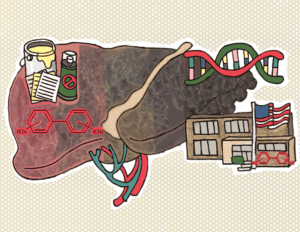 PCBs: A Manmade Menace
PCBs: A Manmade Menace
Kyleakin Helm-Kwasny
Carver College of Medicine
Molecular Medicine
Category: Graduate Student
What would you do upon finding out that the building your child attends school in is filled with an invisible toxin? The effects of this toxin may accumulate over time, and you may not even know that they’ve been affected until they are older. For individuals who attend school in a building built or remodeled between 1950-1980, this fear could be real.
Polychlorinated biphenyls (PCBs) are manmade environmental toxicants that were used in a variety of materials including caulk, paint, glues, plastics, lighting ballasts, carbonless copy paper, and additives in pesticides prior to their ban in 1979. Chronic exposure to PCBs can lead to developmental and behavioral changes, cancer, reproductive toxicity, immune suppression, birth defects, cardiometabolic disease, and liver damage.
My research is focused on PCBs that are found in the air and can result in exposure through inhalation. I aim to understand if and how these PCBs – including one of the major congeners found in the air of older school buildings, PCB 52 and its metabolite PCB 52-OH – contribute to nonalcoholic fatty liver disease (NAFLD). The liver is the major site for PCB metabolism and my lab has shown that liver-related genes, specifically those involved in the fatty acid biosynthesis pathway, can change expression upon PCB exposure.
My submission depicts the progression of NAFLD – from steatosis to steatohepatitis, fibrosis, cirrhosis, and hepatocellular carcinoma – indicated by the color changes in the liver. The background of the liver is from a microscopy image I took of the human hepatocellular carcinoma cell line, HepG2, that I use as a model in my everyday research. The paint bucket, pesticide container, and carbonless copy paper are all examples of PCB-containing products. The school is modeled after the middle school I attended, where the structure was built in 1953. The DNA strand is meant to represent the changes in gene expression that I have observed upon exposing the liver and liver cells to PCB 52 and PCB 52-OH. Lastly, I have included the basic chemical structure of PCBs since they are invisible.
Acknowledgements: Dr. Al Klingelhutz and members of the Iowa Superfund Research Program (ISRP)
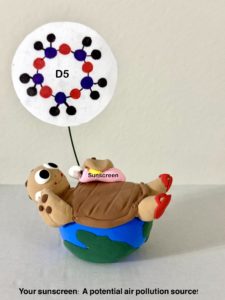 Personal Care Products Are A Potential Threat To Air Quality!
Personal Care Products Are A Potential Threat To Air Quality!
Saeideh Mohammadi
College of Engineering
Chemical and Biochemical Engineering
Category: Graduate Student
Air pollution is one of the main human health risk factors all around the world. Moreover, air pollution plays an important role in climate change. One major group of air pollutants is gaseous species called volatile organic compounds (VOCs). VOCs have a wide range of sources from vehicles and industries to personal care products. Yes, what you read is actually correct! Personal care products such as sunscreen, deodorant, lotion, etc. contain one class of VOCs called cyclic volatile methyl siloxanes (cVMS). If you check the ingredients of your sunscreen, you will see a cVMS compound name like ‘D5’ or ‘Decamethylcyclopentasiloxane’. D5 molecule is what you see in the picture, coming out from that sunscreen. Almost everyone in the world uses these products every day, some days multiple times! However, it is still not quite clear what happens to them in the air and what their impacts are. In addition, since the population of the world is increasing rapidly, their impacts could be influential in the future. My research is focused on finding answers to these questions using laboratory and modeling experiments. The long-term goal of my research is to provide detailed information on what happens to these compounds in the atmosphere, which policymakers can use to employ strategies to reduce their emissions to improve human health and sustainability.
I used air dry clay to make the figure in the picture and I took a photo of that. The turtle is a symbol of the Earth and humans.
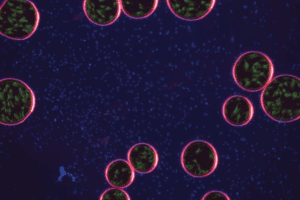 Perspectives
Perspectives
Rion Wendland
College of Engineering
Biomedical Engineering – Carver Lab for Regenerative Engineering and Translational Science
Category: Graduate Student
A fluorescent light microscopy image taken of retinal pigmented epithelial cells grown on polymer substrates as part of a research project for retinal transplantation procedures. This project focuses on eye diseases that result in visual impairments, and the surgical replacement of the dysfunction cells involved in the visual process. However, condensation of water on the slide provided a unique magnification of certain regions, showing insight to areas of the cells not usually seen in this imaging modality. This “mistake” highlights the importance of perspective, not only in research areas, but throughout life. Many things can only be truly appreciated through certain lenses, a lesson of continuing importance in today’s world.
Acknowledgements: Kristan Worthington
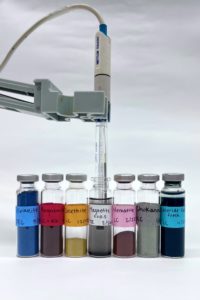 Redox Chemistry Of Iron
Redox Chemistry Of Iron
Libby Chelsvig
College of Engineering
Civil and Environmental Engineering – IIHR Hydroscience and Engineering
Category: Graduate Student
Environmental contamination is an ever-growing problem threatening human and environmental health. Contaminants can be widespread, mobile, and difficult to remediate in the environment using conventional treatment technologies. Abiotic natural attenuation is an energy efficient and passive treatment technology which uses existing environmental conditions to remediate hazardous chemicals to benign products. Iron minerals, which are naturally abundant in soils and sediments, can play a key role in contaminant cycling in the environment. My research focuses on analyzing the electrochemical behavior of iron minerals at environmentally relevant conditions to predict whether the remediation of a contaminant is thermodynamically favorable. Here, I am measuring the redox potentials of suspensions containing iron minerals such as magnetite and goethite, among others. We aim to bridge the gap between demonstrated contaminant reduction capabilities and measured redox behavior of iron minerals by developing models to predict the electrochemical behaviors of iron minerals in the environment. With this work, we hope to advance the effectiveness and efficiency of remediation technologies to sooner clean up contaminants from the environment.
Acknowledgements: Drew Latta, Thomas Robinson, & Michelle Scherer
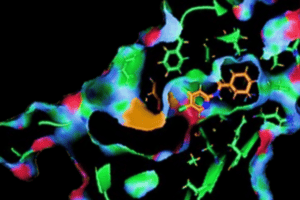 Small Molecule Path To Binding Site
Small Molecule Path To Binding Site
Autumn Moore
Carver College of Medicine
Molecular Physiology and Biophysics – Julien Sebag Laboratory
Category: Faculty/Staff/Researchers
This image is taken of the X-ray crystal structure of small molecule C59 bound to drug target UNC119A. The different colors represent the different interactions on the surface of the protein. The green sticks and hexagons represent amino acid residues within the protein, and the predominately orange structure is C59.
Acknowledgements: I want to acknowledge the Artemyev Group for solving the crystal structure
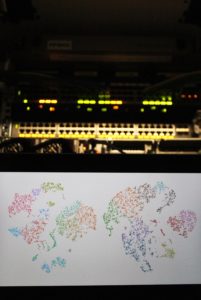 The Art Of Technology
The Art Of Technology
Naila Hanif
College of Liberal Arts & Sciences
Computer Science
Category: Undergraduate Student
Within this photograph is my laptop which is displaying an image, and behind it, is part of University of Iowa’s high performance computing system, Argon. The image displaying on my laptop contains two separate visualizations of two samples from the research project I am working on. The project involves analyzing single cell RNA sequencing data. We are trying to understand the effect that type 1 interferon (a cytokine) has in murine periodontitis, also known as gum disease in mice. My part of this project so far involved me attaining two samples from the sequenced data, one wild type (left in photo) and one with type 1 interferon knocked out (right in photo). I then used the software Cell Ranger to process the single cell sequenced data for each sample. With one of the many outputs received from running Cell Ranger Count, I used the software Loupe Browser to create the visualizations you see on my laptop in the photograph. The visualization is called a t-SNE plot, which exhibits color coded clusters of similar genes. I still have much more to learn and work on within this project, but this is what I have thus far. I used Argon, the high-performance computing system to run Cell Ranger because it allows for much faster processing of data, as I’m working with incredibly large files. Since Argon has been very useful in this project, I thought incorporating it in my photograph was a must and it would be fascinating to see what Argon actually looks like. Luckily, the University of Iowa ITS Research Computing Team gladly gave me a tour of one of the data centers Argon is located in, the Information Technology Facility in Coralville. Argon is comprised of many compute nodes and is essentially a large cluster of servers, but it was captivating seeing this in person. For my photograph I captured only a small part of this large system so it doesn’t do it justice, but I’m ecstatic I could include part of it. Though most of the work I do as part of this research project is done on my computer, I’m thrilled I could find a way to capture the essence of what I have been learning in a photograph.
Acknowledgements: My research professor Erliang Zeng and Jerry Protheroe, the IT director at ITF
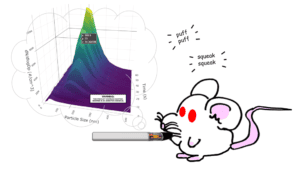 What’s In Your Puff?
What’s In Your Puff?
Vingie Ng
College of Public Health
Occupational and Environmental Health
Category: Graduate Student
I study the effects of vaping on lung function using translational mouse models. And because we are not allowed to show pictures of the mice, I drew a cartoon of a CD1 mouse vaping instead.
In order to characterize the aerosol generated from vaping devices, I use a Fast Mobility Particle Sizer. This instrument measures the concentration and diameter of the small particles in an aerosol. Here you see a 3D visualization of 3 puffs over 60 seconds from the e-cig the mouse is using. Being able to analyze the aerosol this way is important because smaller particles get lodged deeper in the lungs and cause worse consequences.
